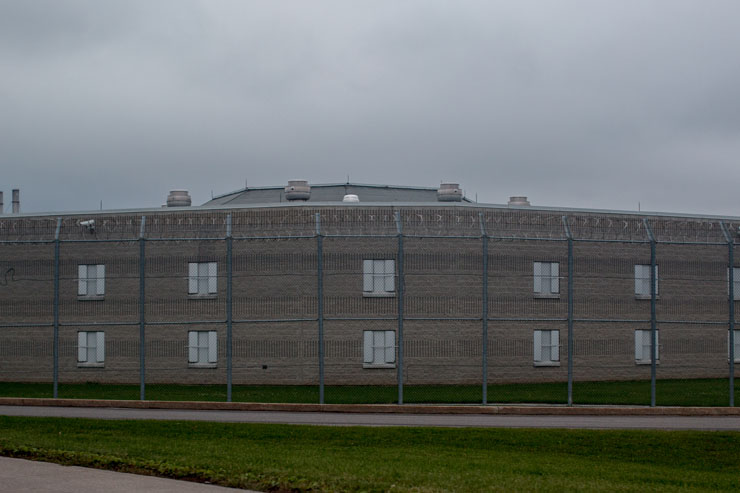We don’t know much about him but we know he was “bizarre.”

“Bizarre behaviour” is what got him placed in solitary confinement in the first place.
“Unpredictable — subject is completely unresponsive — will not speak or make eye contact,” reads the first form reviewing his segregation, on August 28, 2013.
The reasons given for holding him in solitary confinement, ostensibly reviewed every five days, follow that pattern: “Institutional security”; “Incompatible” with the general jail population.
So the man spent the next 390 days in solitary confinement at Ontario’s Central East Detention Centre in Lindsay.
He’d committed no crime to get there. He was held as an “immigration detainee” by Canada’s Border Services Agency, which decided he was a flight risk so should be locked up while they tried to deport him and he fought to stay in Canada.
INVESTIGATION: Canada’s unwanted
DEATH BEHIND BARS: Canada’s sickest inmates are in its deadliest prisons
This happens a lot.
A Global News investigation revealed Canada’s “psychiatric prisons” are the deadliest and most violent in the federal system.
And while the United States and other countries scale back solitary confinement, Canada has not.
There are about 500 immigration detainees across Canada; more than 200 of them are in Ontario. The CBSA doesn’t have space for all the people it locks up, so it sends them to Ontario jails.
Solitary confinement is brutal for anyone: The United Nations considers more than 15 consecutive days in segregation to be torture.
It’s far worse for people whose minds are already unwell.
Yet it’s these people who are most likely to be put in solitary confinement in Ontario and kept there — explicitly because of their mental illness.
READ MORE: Why put sick people in solitary?
We know this because it’s in the documents corrections officers fill out when giving their reasons for segregating inmates.
- Canadian man dies during Texas Ironman event. His widow wants answers as to why
- Canadians more likely to eat food past best-before date. What are the risks?
- Honda’s $15B Ontario EV plant marks ‘historic day,’ Trudeau says
- On the ‘frontline’: Toronto-area residents hiring security firms to fight auto theft
Articling law student Simon Wallace received more than 1,110 pages in response to his access-to-information request for all 30-day segregation forms for Ontario jails between Aug. 1 and Dec. 31, 2014.
Read Ontario’s solitary confinement documents in full
Among the myriad reasons given, the most common include inmates deemed “incompatible”; who posed a threat to “institution security”; who were under “medical observation”; exhibited “bizarre behaviour”; whose erratic behaviour led to “misconduct.”
This doesn’t mean people are just being jerks: These designations can refer to incoherent screaming, to individuals not responding to any external stimuli, to harming themselves, smearing feces on the wall, talking to the voices in their heads.
The vast majority are different ways of saying the same thing: This inmate is in the grip of a serious mental illness and is decompensating.
In several cases, mental illness was explicitly cited as the reason for putting someone in solitary confinement. This often earned reprimands from supervisors but does not appear to have resulted in segregation being terminated.
This “bizarre” immigration detainee was put in jail not despite his mental illness, but because of it: Canada’s border police have a policy of putting sick people in provincial jails on the rationale that the services they will get there are better.
The irony doesn’t escape Renu Mandhane, head of Ontario’s Human Rights Commission.
In her former role as executive director of the University of Toronto’s international human rights program, Mandhane authored a report slamming the CBSA’s detention of people with severe illness.
“We find that people who have serious mental health issues are routinely and almost presumptively transferred to the jails because CBSA believes they will access treatment in the jails,” she told Global News at the time.
“I don’t think anyone believes that these jails have adequate mental health treatment except CBSA.”
It still rankles.
“There’s something very perverse about that outcome.”
WATCH: How do sick people end up in prison?
‘What is the plan of care?’
This man’s illness was the reason he was put in jail. It was also the reason, once in jail, he was placed in solitary confinement.
Correctional documents mark his decline: After 60, 90, 120 days in solitary confinement, his continues to exhibit “bizarre behaviour”; he remains “incompatible” with other inmates. Around the 200-day mark, record-keepers added “own protection” as another reason for his segregation. Later on, forms note the inmate “refuses to respond to questions”; was “unable to function”; “refused to acknowledge staff.”
Two hundred and seventy days in, the supervisor asks, “Please note if there is a plan re: psychologist?”
A month later, at the 300-day mark: “Have there been any psychological assessments of this inmate?”
On June 10, 2014, there’s a first reference to a psychologist, whom the inmate “would not acknowledge.” It appears the interaction ended there.
At no point does the supervisor check off the “Not supported” box to indicate the segregation isn’t justified.
After 345 days of solitary confinement, the inmate was taken to an immigration hearing and “complied with direction with lots of prompting from staff.” Then back to segregation.
At the 360 day mark, the supervisor writes that mental illness “is not a reason for segregation. Please do not use, give explanation of reason. Is there a plan of care/any assessments?”
At 390 days: “Subject is catatonic,” the record reads.
The supervisor’s final note: “What is the plan of care on this inmate?”
That’s the last we hear — the end of documents on this particular inmate in these released records.
It isn’t clear whether the inmate remained in solitary after this or what happened to him. He could have been deported or released; he could still be in solitary confinement.
We do know there were many others like him.
Most of these solitary confinement documents don’t specify whether the inmate in question was convicted of a crime or was being detained by Canada’s border police.
But some explicitly mention immigration hearings.
Another inmate at the Lindsay jail was deemed “non-compliant” and “unresponsive.” Shortly before he was put in solitary confinement he stopped eating.
He was shuttled between segregation and hospitals for the next several weeks, refusing food until at least Day 30 of his segregation.
Corrections officers tried to take the inmate to Waypoint Centre for Mental Health Care but the document says he was “refused.”
“Unsure of plan for this inmate,” that note reads.
The inmate remained on in segregation, now on suicide watch, until Sept. 9, 2014. After 60 days of solitary confinement, he was “released for deportation.”
‘It’s willful blindness’
The federal government, ultimately responsible for these people, has no plans to stop this practice.
They are reviewing the detention program, Scott Bardsley, a spokesperson for Public Safety Minister Ralph Goodale, wrote in an emailed statement.
“The mandate of the Canada Border Services Agency requires it to use detention only when necessary. … CBSA’s mandate also requires it to safeguard the health, well-being and safety of detainees,” Bardsley wrote.
He also said the Red Cross has “full access” to facilities where the border police detain people. The Red Cross was barred from monitoring Ontario jails until the fall of 2014, despite years of entreaties to be granted access.
The Red Cross has expressed concern over Canada’s habit of putting detainees in jail.
Jails “serve a largely punitive function,” its 2012-13 report reads.
“There’s this legal black hole” when immigration detainees are transferred from federal to provincial custody, Mandhane says: Provincial corrections is technically responsible for them but in many ways they’re worse off than other inmates. In addition to being indefinitely locked up, they often lack access to legal assistance and translation services.
WATCH: The long drive to Lindsay jail to visit a detained husband and father
Mandhane argues these are human rights violations — discrimination on the basis of mental illness, exploitation of vulnerable non-citizens and rules around indefinite detention and solitary confinement.
Both levels of government bear responsibility, she said.
“It’s willful blindness on the part of the CBSA,” she said.
“If Ontario is going to accept these detainees then it is incumbent upon them to ensure that it protects their rights under the Human Rights Code.”
WATCH: Has CBSA made changes following inmates’ deaths?














Comments